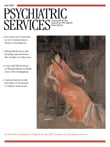Reduction in Postdischarge Suicide in Sweden
To the Editor: In an article in the February 2007 issue, Pirkola and colleagues (
1 ) reported a reduction in postdischarge suicide after deinstitutionalization and decentralization of psychiatric hospital care in Finland in the early 1990s. Similar structural changes in psychiatric hospital care were undertaken in Sweden a few years later, with a shift in the responsibility for inpatient care from psychiatric hospitals at the county council level to institutions at the community level (
2 ). Even though the current suicide rate in Sweden is two-thirds of the rate in Finland (
3 ), suicide is the fifth leading cause of the burden of disease in Sweden among men and the 11th among women (
4 ).
Nationwide Swedish registers were used to estimate postdischarge suicide rates for three periods—1987–1992, 1993–1998, and 1999–2004—representing psychiatric inpatient care before, during, and after the structural changes. Data on all suicides (N=23,742) were collected from the National Cause-of-Death Register in Sweden for 1987 through 2004. The cases were linked to the Swedish hospital discharge register. In line with findings of Pirkola and colleagues (
1 ), postdischarge suicide was defined as occurring within a year of discharge from a psychiatric ward.
Postdischarge suicide rates were lower in the later periods—that is, during and after structural changes. Adjusting for length of hospital stay did not alter the results. Compared with 1987–1992, the relative risk for 1993–1998 was .85 (95% confidence interval [CI]=.80–.91), and for 1999–2004 it was .89 (CI=.83–.95). [A table with additional data on suicides for these periods is available in an online supplement to this letter at ps.psychiatryonline.org.]
Restricting the analyses to immediate suicide, defined as within a week of discharge, also showed a lower relative risk in the later periods. Widening the definition to include patients hospitalized with a primary psychiatric diagnosis regardless of clinic (that is, including patients treated in general inpatient care but with psychiatric consultants in some cases) showed very similar results. Postdischarge suicide stratified by specific diagnoses was not studied, although a previous study has shown an increase in suicide rates among patients with schizophrenia in the mid-1990s in Sweden (
5 ).
In-depth analyses of all suicides occurring in 2004 revealed that of the 1,154 cases (Sweden has a population of close to nine million), 61% (N=709) had received either general or psychiatric inpatient or outpatient care in a specialty setting (that is, not in primary care) at least once during the past year. Of these 709 cases, 50% (N=351) had contact with inpatient or outpatient care within the week before suicide.
The findings support the conclusions drawn by Pirkola and colleagues (
1 ), indicating that in terms of postdischarge suicide rates the downsizing of psychiatric hospital care has not been harmful. However, it must be noted that approximately 20% of persons who committed suicide had received psychiatric inpatient care in the past year and more than 60% had consulted a physician in the past year, half of them during the week before the suicide. These findings clearly emphasize the need for better recognition of suicidal risk among professionals in both general and psychiatric care settings.

